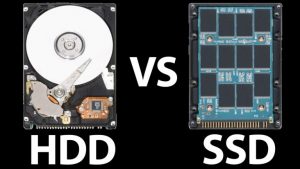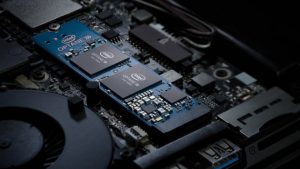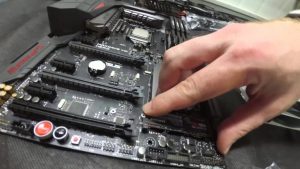An SSD (Solid-State Drive) is an increasingly used data storage medium, both by individuals and companies. Find out everything you need to know about it: definition, advantages, different types…
Since the late 2000s, the SSD has gradually replaced hard drives in desktops, data centre servers and workstations. It is a powerful, fast, reliable and efficient data storage medium.
Concretely, an SSD consists of an assembly of memory chips on a printed circuit. An in / Out interface (generally SATA or PCIe) provides power to this assembly and ensures data transfer.
SSD vs HDD: what are the differences?
To fully understand what an SSD hard drive is, it is useful to compare it with HDDs (Hard Disk Drives). Once the most widely used storage medium, the hard drive provided “non-volatile” storage based on physical forces: movement and magnetism.
These are disks that spin and write code, housed in a magnetic mantle to preserve data. Reliable, easy to use, HDDs have long been popular because there was no better alternative.
However, the arrival of the SSD has changed that. This technology is based on flash memory. So, rather than physically writing the data to a disk, these devices use memory chips (like NAND chips). Within these chips, semiconductors are arranged in different states of electric charges in order to store the code. Only the electrical patterns move, and this is the reason why we speak of “solid-state”.
SSD: what are the advantages?
SSD has many advantages over HDD. First of all, it does not have any moving parts. This is an important asset, as these parts can be easily damaged. For example, when a laptop is dropped, the HDD may break. This is not the case with SDD. Thus, they are generally more durable and reliable than HDDs.
Also, because of the speed at which electrical patterns move, SSDs can write or read data at a much faster rate than HDDs. Energy consumption is also much lower, which also limits heating and preserves autonomy (in the case of laptops).
They are also smaller and lighter than HDDs. This is what made laptops, tablets and other mobile devices much thinner. The most refined devices have an SSD directly integrated into the motherboard. They also have different shapes and sizes, depending on the number of chips they embed and the arrangement of these components.
Another advantage: malfunctions are much rarer for SSDs than for HDDs. This is notably linked to functions such as the ECC (error-correction code) which makes it possible to avoid errors.
Equality: the heat
However, both devices are sensitive to heat. When they exceed 50 degrees Celsius, the possibilities of reading and writing errors multiply. A data centre manager must, therefore, ensure sufficient ventilation of the racks. Moreover, temperature variations of about 5 degrees would drastically reduce the life of the equipment. In this sense, manufacturers are offering more and more dedicated fans. They come to meet the demand of users of NVMe SSDs whose heating capacities are impressive. Some models reach over 100 degrees Celsius.
What are the different types of memory?
There are three different types of memory for SSDs: SLC, MLC and TLC. In the case of
Single-level cell (SLC), each cell can store a piece of data (1 or 0). Thus, each cell can only read two different values. This is what allows SLC memory to be the fastest and most accurate for writing, consume the least amount of power, and be the most durable. Unfortunately, it is also the most expensive. This is the reason why this type of memory is mainly used by businesses.
Multi-level cell (MLC) memory allows each cell to store two pieces of data (1 and 0). There are therefore four different possible values: 00, 11, 01, and 1. In fact, the MLC allows expanding the storage capacity without increasing the dimensions of the SSD. The price is also cheaper than that of the SLC. On the other hand, the writing speed is slower and less precise, and the power consumption is much more important. MLC SSDs are currently the most common on high-end devices.
Finally, Triple-level cell (TLC) memory allows each cell to store three pieces of data. Thus, their storage capacity is higher for a much cheaper price. On the other hand, the writing and reading speed is slower and less precise and the power consumption even higher than for MLC SSDs.
SSD: what are the different types of connections?
There are different types of connections for SSDs. In general, there are three main categories.
SATA III is the final evolution of the SATA connection, which is found on both HDDs and SSDs. This versatility came in handy when transitioning from HDD to Solid State Drive. However, now that it is gradually becoming the most used storage medium, SATA III connections are becoming less popular. For good reason, they can only support a bandwidth of 600 megabytes per second on average. The support in question must still be connected to a SATA III 6GB/second port.
PCIe (Peripheral Component Interconnect Express) allows you to connect the SSD directly to the PCIe lines of motherboards. Thus, the data flow is more direct. Operations are accelerated. The maximum write speed can reach 1Gb per second. Unfortunately, this connection is currently a bit expensive. It should, therefore, be reserved for users seeking maximum performance.
NVMe (Non-Volatile Memor Express) is designed to make PCIe connections more versatile, easier to update, and faster. This is the most recent connection, and therefore the most expensive at the moment. For example, in 2019, an NVMe SSD connected in M2 of 500 GB costs the same price as a SATA III 250 GB model in 2017. However, due to its performance, NVMe should quickly become more democratic over the coming years.
What future for SSDs?
Over time, HDDs will become increasingly rare. They will certainly still be used to store very large amounts of data, but SSDs are set to become the new standard. It is now even commonly found on the most economical configurations. However, this is only one solution among many in the context of Big Data and Cloud storage.
If they make it possible to speed up data access and migration, these clusters of Flash memory chips have a limited lifespan depending on their use. They are not recommended for long term storage.
False ideas to counterbalance
The lifespan of a Solid State Drive really depends on the number of writes and reads, the electrical charges received, but the most used (in a cloud, big data and analytics context) take about 3 years. Many products on the market contradict this average. Some of them are guaranteed for 10 years, indicating that they could work for several decades in the context of office use. We will have to wait a few more years to draw a clear picture of this variable.
In turn, the SSD will probably eventually be replaced. However, no truly viable technology is able to fulfil this role to date. We will probably have to wait for quantum storage technology to develop to see the end of the reign of Solid-State Storage.
About the author
DMTwebhosting.com’s Editorial Team prides itself on bringing you the latest web hosting news and the best web hosting articles!
You could also link to the news and articles sections:
http://www.DMTwebhosting.com/blog




